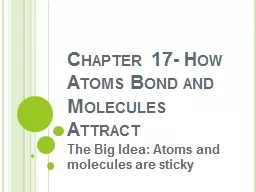

Chapter 17 How Atoms Bond and Molecules Attract The Big Idea Atoms and molecules are sticky 171 ElectronDot Structures Valence electrons electrons in outermost shell Electron dot structures a series of dots surrounding an atomic symbol ID: 764427
Download Presentation The PPT/PDF document "Chapter 17- How Atoms Bond and Molecules..." is the property of its rightful owner. Permission is granted to download and print the materials on this web site for personal, non-commercial use only, and to display it on your personal computer provided you do not modify the materials and that you retain all copyright notices contained in the materials. By downloading content from our website, you accept the terms of this agreement.
Chapter 17- How Atoms Bond and Molecules Attract The Big Idea: Atoms and molecules are sticky
17.1 Electron-Dot Structures Valence electrons= electrons in outermost shell Electron- dot structures: a series of dots surrounding an atomic symbol Electron-dot structures help us understand ionic and covalent bonds Nonbonding pairs= electrons that are relatively stable and are already in pairs
17.2 The Formation of Ions Ion - an element w/ a net electric + or – charge, caused by a loss(+) or gain(-) of electrons Atoms tend to gain/loose electrons to have a filled outermost shell The periodic table tells us the type of ion each atom tendsto form.
17.3 Ionic Bonds An ionic bond is the electric force of attraction between two oppositely charged ions. Ionic compounds form when 2 ions come together to create a compound.-Ionic compounds have different properties than the ions from which they were made.
The Chemistry of Minerals For all ionic compounds, positive and negative charges must balance. Ionic bonds usually form from elements on opposite sides of the periodic table Ex: Aluminum oxide. Al +3 + O-2= Al2O3
17.4 Metallic Bonds Metallic bond- when metal ions are held together by freely flowing electrons. -This accounts for metal’s ability to conduct electricity and heat, as well as it’s ability to be bent and shaped. An alloy is a mixture or two or more metallic elements
17.5 Covalent bonds Covalent bonding is when atoms are held together by a mutual attraction to the electrons they share. Covalent compounds is when 2 or more substances are held together by covalent bonds. This forms a molecule . -Chemists use a straight line to symbolize two electrons involved in a covalent bond
# of covalent bonds an atom can form= # of electrons needed to fill it’s outermost shell
17.6 Polar Covalent bonds Electronegativity- how strongly an atom can tug on bonding electrons. Dipole- separation of charge that occurs in a chemical bond b/c differences in electronegativity of bonded atoms The greater an atom’s electronegatvivity, the greater it’s ability to pull electrons towards itself when bonded.
A nonpolar bond happens when no dipole is formed because the two atoms have relatively the same electronegativity Polar bonds form when a very electronegative atom and a weakly electronegative atom are covalently bound.-The further away elements are from each other on the periodic table, the larger difference they have in electronegativity.
17.7 Molecular Polarity When dipoles go in the opposite direction with equal strength, they cancel out and the molecule is nonpolar
17.8 Molecular Attractions The strength of the strongest attractions is still weaker than chemical bonds
Ion-dipole: bond between an ion and polar dipole molecule Dipole-dipole: bond between 2 polar molecules. - Ex of strong dipole-dipole: hydrogen bond.- When H bonds to N,O, or F-Reason why water had such high boiling pointDipole-induced dipoles: temporary uneven distribution of electrons